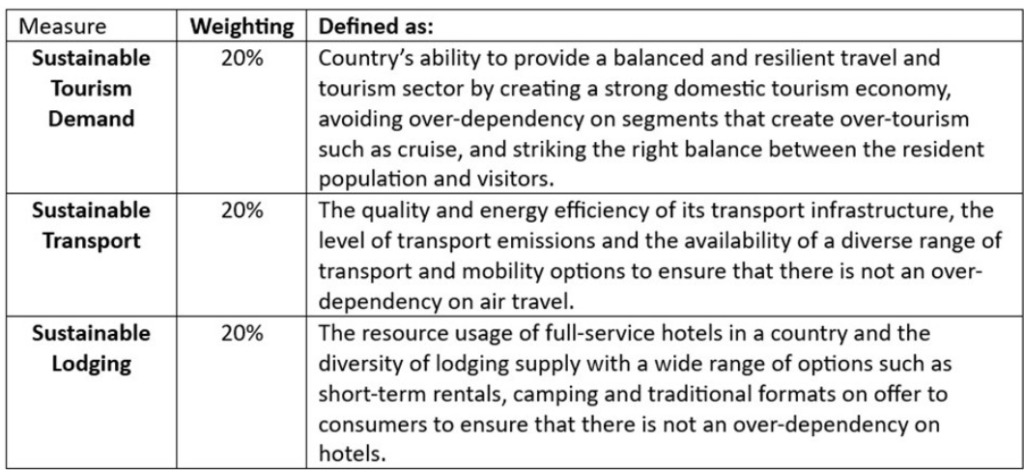
On holidays in France last week, I was reading the newspaper reports that Ireland was projected to fall well short of climate targets. It set me thinking about whether it was inevitable that we would need to significantly curtail international tourism and I started to wonder whether there were any countries that were making real progress on solving the challenges of making international tourism sustainable and if so how.
Sustainable Travel Index 2020 Ranking
No country has got it right yet – but the country that appears to be doing best is Sweden, a country I know well having spent a year there in the early 1990s. Sweden is number one out of 99 countries measured by the latest Euromonitor Sustainable Travel Ratings (2020).

Source: Euromonitor International from official sources, 2021
It’s worth looking at the key drivers of these rankings before looking at what other countries can learn from Sweden’s performance.

The other four factors, with the 10% weighting each, are: environmental sustainability, social sustainability, economic sustainability, and risk.
Sweden has, of course, long been an environmental pioneer – consistently one of the top 10 countries in the global Environmental Performance Index produced by Columbia and Yale Universities, and is the birthplace of the world’s leading climate advocate Greta Thunberg.
But it is its purposeful approach to sustainable tourism that has given it this number one position.
Here are four things that Sweden is doing that other countries can learn from
- Putting sustainability at the heart of the tourism strategy. The Swedish state has as its vision: “Sweden by 2030 is the world’s most sustainable and attractive destination based on innovation”. It’s not just at a national level that there is a concerted and tangible focus on sustainability – it’s at a city level too. Gothenburg takes great pride that it has been number one for seven years in the Global Destination Sustainability Index . #sustainabletourism
- Working with geographical realities. Sweden (like Ireland) has sustainability challenges inherent in its location on the outskirts of Europe. It addresses these by a strategy of generating higher levels of value from each visitor by encouraging longer stays including tourists travelling (sustainably) around their Swedish destinations. Key travellers targeted by Visit Sweden are those that can travel sustainably to Sweden (by rail or car) without needing to take a flight. A brand-new EuroNight sleeper train offering a no-fly sustainable travel option from London to Stockholm in less than 24 hours has just been announced. The train is powered by renewable energy with Swedish operator SJ only using hydro- and wind-powered electricity. This article for the World Economic Forum shows how Swedish attitudes towards taking planes for tourism has changed in recent years – could #sweden again be leading the way?
- Sharing the country’s passions. The Swedes love nature. No matter what time of year, Swedes spend a good part of their free-time outdoors and nature is made freely accessible to all by the Allemansrätten. This Freedom to Roam law, written into the Swedish constitution in 1994, allows anyone to walk, cycle, ride, ski and camp on any land (excluding private gardens, near a dwelling house or land under cultivation). The law also allows anyone to pick wildflowers, mushrooms and berries. This easy and welcoming access to the beauties of Swedish nature led the Swedish tourist marketing agency to list their whole country on Airbnb. Building on their love of nature, in 2002 Sweden became the second country in the world (after Australia) to introduce an ecotourism charter. The Nature’s Best label certifies tour operators focused on Sweden’s fast growing ecotourism sector.
- Developing classy, imaginative sustainable lodging. Sweden is renowned for its style and architecture as well as its love of nature and it brings both together to create sustainable and chic accommodation (check out some examples here). There are more than 250 hotels in Sweden that have met the strict requirements of the Nordic-Eco Label. This Pan-Nordic label is acquired by meeting criteria including the building’s energy use, waste management, food sources, water use, transportation and suppliers.
I loved Sweden and always felt that it was one of Europe’s hidden tourism gems. It seemed to me then that the beauty of the country was a secret Swedes wanted to keep for themselves. Researching this blog, it is clear to me they are willing to share its magnificence with us – but only if it can be done in a sustainable way.
Published on 9 June 2023
Source: Momentahub
Author: Jean Callanan is a Strategic Thinking Consultant and Sustainable Innovation Facilitator who blogs on businesses doing inspiring things to create a better world.
SDG solution: SDG 8



